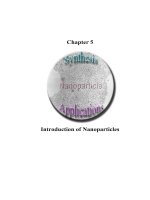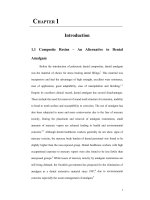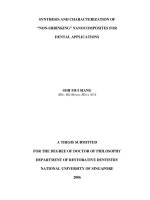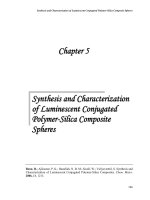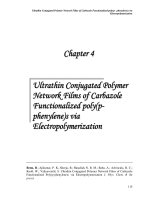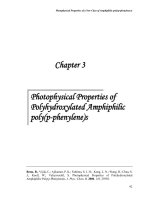Synthesis and characterization of new metal carbon catalysts for hydrogenation of d glucose
Bạn đang xem bản rút gọn của tài liệu. Xem và tải ngay bản đầy đủ của tài liệu tại đây (3.8 MB, 179 trang )
SYNTHESIS AND CHARACTERIZATION OF NEW
METAL-CARBON CATALYSTS FOR
HYDROGENATION OF D-GLUCOSE
LIU JIAJIA
NATIONAL UNIVERSITY OF SINGAPORE
2010
SYNTHESIS AND CHARACTERIZATION OF NEW
METAL-CARBON CATALYSTS FOR
HYDROGENATION OF D-GLUCOSE
LIU JIAJIA
(M.Eng, Tianjin University)
A THESIS SUBMITTED
FOR THE DEGREE OF DOCTOR OF PHILOSOPHY
DEPARTMENT OF CHEMICAL AND BIOMOLECULAR
ENGINEERING
NATIONAL UNIVERSITY OF SINGAPORE
2010
Acknowledgement
i
Acknowledgement
I am heartily thankful to my supervisor, Assoc. Prof. Zhao X. S., George, whose
constant encouragement, invaluable guidance, patience and support throughout the
whole period of my PhD candidature. I would also like to thank Assoc. Prof. Zhao for
his guidance on writing scientific papers including this PhD thesis.
In addition, I want to express my sincerest appreciation to the Department of
Chemical and Biomolecular Engineering for offering me the chance to study at NUS
with a scholarship.
It’s my pleasure to work with a group of brilliant, warmhearted and lovely people.
Wish all my lab mates go well with their work.
Particular acknowledgement goes to Dr. Liu Tao, Mr. Chia Phai Ann, Mr. Shang
Zhenhua, Dr. Yuan Zeliang, Mr. Mao Ning, Mr. Liu Zhicheng, Dr. Rajarathnam D.,
Madam Chow Pek Jaslyn, Mdm Fam Hwee Koong Samantha, Ms Lee Chai Keng, Ms
Tay Choon Yen, Mr. Toh Keng Chee, Mr. Chun See Chong, Ms. Ng Ai Mei, Ms. Lum
Mei Peng Sharon, and Ms. How Yoke Leng Doris for their kind supports.
I thank my parents and my husband. It is no exaggeration to say that I could not
complete the PhD work without their generous help, boundless love, encouragement
and support.
Lastly, I offer my regards and blessing to all of those who supported me in any
respect during the completion of the project.
Table of Contents
ii
Table of Contents
Acknowledgement i
Table of Contents ii
Summary v
Nomenclature viii
List of Tables ix
List of Figures x
Chapter 1. Introduction 1
1.1 Hydrogenation reactions 1
1.2 Importance of hydrogenation of D-glucose 3
1.3 Catalysts for hydrogenation reactions 3
1.4 Carbon-supprted catalysts for hydrogenation reactions 6
1.5 Recent advance on template approach to preparing novel porous
carbons and catalysts 7
1.6 Objective of project 8
1.7 Structure of thesis 9
Chapter 2. Literature review 11
2.1 Hydrogenation reactions 11
2.2 Catalysts in hydrogenation reactions 13
2.3 Hydrogenation of D-glucose 37
2.4 Porous carbon as a catalyst support 43
Chapter 3. Experimental section 59
3.1 Chemicals 59
3.2 Synthesis methods 60
Table of Contents
iii
3.3 Characterization techniques 63
3.4 Evaluation of catalytic properties 75
Chapter 4. Ru nanoparticles embedded in templated porous carbon and catalytic
performance in D-glucose hydrogenation 77
4.1 Introduction 77
4.2 Characterization of Ru nanoparticles catalysts 77
4.3 Catalytic properties 84
4.4 Summary 91
Chapter 5. Bimetallic Ru-Cu nanoparticles sandwiched in porous carbon 92
5.1 Introduction 92
5.2 Characterization of bimetallic Ru-Cu catalysts 94
5.3 Catalytic properties 106
5.4 Summary 108
Chapter 6. Ruthenium nanoparticles embedded in mesoporous carbon fibers 109
6.1 Introduction 109
6.2 Characterization of Ru nanoparticles catalysts 111
6.3 Catalytic properties 122
6.4 Summary 126
Chapter 7. Kinetics of the catalytic hydrogenation of D-glucose over bimetallic Ru-
Cu carbon catalyst 127
7.1 Introduction 127
7.2 Kinetics of the hydrogenation of D-glucose 128
7.3 Modeling results of kinetics and mechanism 132
7.4 Summary 135
Chapter 8. Conclusions and recommendations 137
Table of Contents
iv
8.1 Conclusions 137
8.2 Recommendations 139
References 140
Appendix 162
Summary
v
Summary
Catalytic hydrogenation is a process for the reduction of chemical substances, and
has found numerous applications in the chemical and petrochemical industries. The
hydrogenation reaction can be carried out heterogeneously or homogeneously. The
heterogeneous catalysts are in generally a metal supported on a solid that are prepared
by using conventional methods, such as impregnation followed by hydrogen reduction.
Such supported catalysts suffer from a number of problems, such as aggregation and
leaching of the metal particles. Thus, new methods that afford the preparation of
catalytically highly active, chemically and thermally stable, technically reusable, and
cost-effective are highly desirable.
In this thesis work, the template strategy was employed to prepare new
heterogeneous catalysts. The catalysts were characterized using a number of
techniques, such as extended X-ray absorption spectroscopy (XAS) and chemisorption
of hydrogen and carbon monoxide. The catalytic properties of the catalysts were
evaluated using the hydrogenation of D-glucose in a batch reactor.
First, ruthenium nanoparticles embedded in the pore walls of templated carbon
(denoted RuC) were prepared by using H-form zeolite Y and mesoporous silica SBA-
15 as templates. Compared with other ruthenium catalysts prepared using conventional
methods, the RuC catalysts prepared using the template method exhibited a
significantly improved catalytic performance because of the unique structure of the
RuC catalysts.
Second, bimetallic ruthenium-copper (Ru-Cu) nanoparticles embedded in the pore
walls of mesoporous carbon were prepared. The presence of bimetallic entities was
supported by the characterization data of both Ru L
III
-edge and Cu K-edge X-ray
Summary
vi
absorption. It was observed that additional active sites were created because of the
spillover of H from Ru to Cu at low Cu contents while three-dimensional islands of
segregated metallic Cu phase covering the surface of Ru nanoparticles appeared at
high Cu contents.
Third, alumina microfibers were also used as templates to prepare Ru nanoparticles
embedded in mesoporous carbon fibers. In comparison with Ru nanoparticles
supported on other carbon materials (e.g., multi-walled carbon nanotubes, carbon
fibers, alumina microfibers, and the activated charcoals), the Ru catalyst prepared
using the template method displayed a remarkably higher catalytic activity and a better
stability, again attributed to the features of unblocked mesopores, hydrogen spillover,
and unique surface contact between the Ru nanoparticles and the carbon supports. In
addition, the incorporation of nitrogen significantly improved the catalytic
performance due to the enhanced hydrogen adsorption, improved surface wettability,
and modified electronic properties of the Ru nanoparticles.
Fourth, the kinetics of D-glucose hydrogenation over a bimetallic catalyst was
studied. In the operation regime studied, the reaction rate showed a first order
dependency with respect to hydrogen. The rate dependence on D-glucose was found to
be concentration-dependent: at low D-glucose concentrations the reaction rate showed
a first order dependency while at higher concentrations a zero order behavior was
observed. Experimental data were fitted to the kinetic model using the Matlab software
with the fminsearch method. The kinetic model was found to nicely predict the
experimental data.
In short, the template method offers opportunities to prepare novel solid catalysts
with unique properties, such as controllable catalyst particle size, enhanced catalyst
dispersion, improved thermal stability, lowered diffusion resistance of both reagent
Summary
vii
and product, and intimate interfacial contact between metal particles and the carbon
support. In addition, the template method could be extended to the preparation of
bimetallic or tri-metallic carbon nanocomposites. Furthermore the template method
allows one to easily control the chemical properties of carbon by changing carbon
precursor (incorporation of heteroatom such as nitrogen).
Nomenclature
viii
Nomenclature
1D One-dimensional
3D Three-dimensional
o
C Degree Centigrade
λ Wavelength
BET
Brunauer-Emmett-Teller
BJH
Barrett-Joyner-Halenda
CVD Chemical vapor deposition
d Diameter
DI Deionized
EDX Energy dispersive X-ray spectroscopy
FT-IR Fourier transform infrared
FESEM Field emission scanning electron microscopy
h hour
HK Horvath-Kawazoe method
HRTEM High-Resolution Transmission Electron Microscopy
mL mille liter
nm nanometer
P123
Poly(ethylene glycol)
20
-block poly(propylene glycol)
70
-block
poly(ethyleneglycol)
20
PSD Pore size distribution
SBA Santa Babara
SEM Scanning electron microscopy
TEM Transmission electron microscopy
TEOS Tetraethyl orthosilicate
TGA Thermogravimetric analysis
XAS X-ray Absorption Spectroscopy
XPS X-ray Photoelectron Spectroscopy
XRD X-ray Diffraction
List of Tables
ix
List of Tables
Chapter 3
Table 3.1 Chemicals used in this thesis work.
Chapter 4
Table 4.1 Physicochemical properties of Ru catalysts.
Table 4.2 Physicochemical properties of Ru catalysts prepared under different
experimental conditions.
Chapter 5
Table 5.1 Physicochemical properties of bimetallic Ru-Cu catalysts.
Table 5.2 The chemisorption results of the catalysts.
Chapter 6
Table 6.1 Physicochemical properties of Ru catalysts.
Table 6.2 Metallic dispersions and average particle sizes of Ru catalysts calculated
from CO chemisorption.
Chapter 7
Table 7.1 Comparison of the fitted parameters for D-glucose hydrogenation over
RuCu0.5C catalyst.
List of Figures
x
List of Figures
Chapter 1
Figure 1.1 Components of a fat molecule (a), Fat triglyceride shorthand formula (b).
Chapter 2
Figure 2.1 Schematic representation of the catalytic hydrogenation mechanism.
Figure 2.2 Schematic presentation of in-situ metal introduction into mesoporous
materials method (Boualleg et al., 2009).
Figure 2.3 Schematic route to dendrimer-derived supported nanoparticle catalysts
(Lang et al., 2003).
Figure 2.4 Illustration of the immobilization of Pd nanoparticles at the surface of a
molecular sieve with an ionic liquid layer (Huang et al., 2004).
Figure 2.5 Schematic presentation of formation of Pt particles on the surface of the
spherical polyelectrolyte brush particles (Sharma, et al., 2007).
Figure 2.6 Schematic presentation of preparation of the magnetic, chirally modified
Pt/SiO
2
/Fe
3
O
4
catalyst (M represents cinchonidine) (Panella et al., 2009).
Figure 2.7 Schematic representation of some possible mixing patterns of bimetallic
nanoparticles: (a) core-shell, (b) subcluster segregated, (c) mixed, (d)
three shell (Ferrando et al., 2008).
Figure 2.8 Schematic representation of promoter effect in hydrogenation of
cinnamaldehyde (M
+
=Li
+
, Na
+
, or K
+
) (Koo-amornpattana and
Winterbottom, 2001).
Figure 2.9 Reichstein process for the production of ascorbic acid from D-glucose.
Figure 2.10 Reaction pathways for the production of alkanes from sorbitol over
catalysts with metal and acidic components (Huber et al., 2004).
List of Figures
xi
Figure 2.11 (a) Hydrogenation of D-glucose to D-sorbitol, (b) Lobry de Bruyn-van
Ekenstein transformation of D-glucose (Hoffer et al., 2003).
Figure 2.12 Schematic representation of the reaction mechanism between adsorbed β-
D-glucopyranose and hydrogen (Crezee et al., 2003).
Figure 2.13 Some types of oxygen surface groups in activated carbon (Rodríguez-
reinoso, 1998).
Figure 2.14 Different types of CNTs and CNFs.
Figure 2.15 Scheme of synthesis of the porous materials with the (a) soft template; (b)
hard template.
Figure 2.16 Structural models of ordered microporous carbons prepared using
different zeolite templates (Ma et al., 2001).
Figure 2.17 Structural models for ordered mesoporous carbons synthesized by using
(a) MCM-48 as template (Lee et al., 1999); (b) SBA-15 silica as template
(Lu and Schüth, 2006).
Figure 2.18 Synthetic procedures for uniform porous carbons of tunable pore sizes
through colloidal crystal template approach (Chai et al., 2004).
Figure 2.19 Schematic drawing of a) Pt/ordered mesoporous carbon prepared by a
convention method, and b) the PtC-nanocomposite array synthesized
using an SBA-15 template nanoreactor (Choi et al., 2005).
Figure 2.20 Nitrogen functionalities occurring in carbonaceous materials: a) pyridinic,
b) pyrrolic, c) pyridonic, d) quaternary, and e) oxidized nitrogen
(Machnikowski et al., 2004).
Chapter 3
Figure 3.1 Synthesis setup used in this work.
Figure 3.2 Photo of ChemBET Pulsar system (Quantachrome).
List of Figures
xii
Figure 3.3 Three regions of XAS spectrum.
Figure 3.4 Schematic diagram of the photoelectron wave leaving atom A is
backscattering by the neighbor atom B. An EXAFS oscillation originates
from the interference between the outgoing and the incoming waves
(Lynch, 2003).
Figure 3.5 Photo of Par batch reactor (Parr4560).
Chapter 4
Figure 4.1 FESEM images of (a) hard templates zeolite HY, (b) catalyst RuC(HY),
(c) hard template SBA-15, (d) catalyst Ru6C3.
Figure 4.2 TEM images of catalysts: (a, b) RuC(HY), (c, d) Ru6C3, (e) Ru/C-HY-H,
(f) Ru/C-SBA15-H.
Figure 4.3 XRD patterns of catalysts: (a) RuC(HY), (b) Ru6C3, (c) Ru/C-HY-H, (d)
Ru/C-SBA15-H, and (e)Ru/C.
Figure 4.4 N2 adsorption-desorption isotherms and pore size distribution curves
(inset) of catalysts: (a) RuC(HY), (b) Ru6C3, (c) Ru/C-HY-H, (d) Ru/C-
SBA15-H, (e) Ru/HY-H, (f) Ru/SBA15-H, (g) 5RuC, (h) Ni65.
Figure 4.5 Weight loss curves of catalysts: (a) RuC(HY) and (b) Ru6C3.
Figure 4.6 Catalytic activities of the Ru catalysts.
Figure 4.7 Catalytic activities of the RuC catalysts prepared under different
experimental conditions.
Figure 4.8 XRD patterns of catalysts: (a) Ru12C3, (b) Ru8C3, and (c) Ru6C3.
Figure 4.9 TEM image of catalyst Ru12C3.
Figure 4.10 TEM images of (a) fresh Ru8C2 and (b) Ru8C2 after five-reaction runs.
List of Figures
xiii
Chapter 5
Figure 5.1 Monte Carlo simulation results for Ru-Cu/SiO
2
catalysts with a total
metal dispersion of 30%; (a) 2% Cu, (b) 5% Cu, (c) 10% Cu, (d) 15% Cu,
(e) 20% Cu, (f) 30% Cu (Smale et al., 1989).
Figure 5.2 N2 adsorption-desorption isotherms and pore size distribution curves
(inset) of catalysts: (a) RuC, (b) RuCu0.3C, (c) RuCu0.5C, (d) RuCu1.0C,
(e) RuCu1.5C, and (f) CuC.
Figure 5.3 XRD patterns of catalysts: (a) RuC, (b) RuCu0.3C, (c) RuCu0.5C, (d)
RuCu1.0C, (e) RuCu1.5C, (f) CuC.
Figure 5.4 TEM images of catalysts: (a) RuC, (b) CuC, (c) RuCu0.5C, and (d)
HRTEM image of RuCu0.5C showing the stacking of graphite sheets
[d(002)=0.36 nm].
Figure 5.5 (a) the SEM image of the RuCu0.5 sample, and elemental mapping of C
(b), Ru (c) and Cu (d), respectively, correspond to (a).
Figure 5.6 (a) Ru LIII-edge XANES spectra of RuC and RuCu0.5C catalysts, (b) Cu
K-edge XANES spectra of RuCuC catalysts.
Figure 5.7 (a) Cu K-edge EXAFS data, (b) k2-Weighted Fourier-transform (not
phase-corrected) for RuCuC catalysts at the Cu K-edge (A: Cu-O, B: Cu-
Cu from Cu metal).
Figure 5.8 H2 pulse titration peaks of catalysts: (a) RuC, (b) RuCu0.3C, (c)
RuCu0.5C, (d) RuCu1.0C, (e) RuCu1.5C.
Figure 5.9 CO pulse titration peaks of catalysts: (a) RuC, (b) RuCu0.3C, (c)
RuCu0.5C, (d) RuCu1.0C, (e) RuCu1.5C.
Figure 5.10 Catalytic activities of the catalysts.
List of Figures
xiv
Chapter 6
Figure 6.1 Schematic illustration of the synthesis of nanoporous carbon nanotubes
by using organic surfactant filled inside channels of porous anodic
alumina membrane as a dual template (Rodriguez et al., 2006).
Figure 6.2 N2 adsorption-desorption isotherms and pore size distribution curves
(inset) of catalysts: (a) Ru/AF-H, (b) RuCMF, (c) RuCMFN, (d)
Ru/CNT-H, (e) Ru/CF-H, (f) 5RuC.
Figure 6.3 XRD patterns of catalysts: (a) RuCMF, (b) RuCMFN, (c) Ru/AF-H, (d)
Ru/CNT-H, and (e) Ru/CF-H.
Figure 6.4 FESEM images of catalysts: (a) Ru/AF-H, (b) RuCMF, (c) RuCMFN, (d)
Ru/CNT-H, (e) Ru/CF-H, and (f) 5RuC.
Figure 6.5 TEM images of catalysts: (a, b) RuCMF, (c, d) RuCMFN, (e) Ru/AF-H,
(f) Ru/CNT-H, (g, h) Ru/CF-H.
Figure 6.6 CO pulse titration peaks of catalysts: (a) RuCMF, (b) RuCMFN, (c)
Ru/AF-H, (d) Ru/CNT-H, (e) Ru/CF-H, (f) 5RuC.
Figure 6.7 The XPS survey spectrum of catalysts: (a) RuCMF, (b) RuCMFN, the
C1s XPS spectrum of (c) RuCMF, (d) RuCMFN, (e) N 1s XPS spectrum
of RuCMFN, and (f) types of nitrogen functionalities in RuCMFN.
Figure 6.8 FT-IR spectra of the RuCMF and RuCMFN.
Figure 6.9 Catalytic activities of the catalysts.
Figure 6.10 H
2
pulse titration peaks of catalysts: (a) RuCMF and (b) RuCMFN.
Chapter 7
Figure 7.1 (a) the Fischer projection of the chain form of D-glucose, (b) α-D-
glucopyranose, and (c) β-D-glucopyranose.
List of Figures
xv
Figure 7.2 (a) The effect of the impeller speed on the initial reaction rate at 100 oC
and 8MPa; (b) The influence of catalyst loading on the initial reaction rate
at 100 oC and 8MPa.
Figure 7.3 Arrhenius plots of the initial D-glucose (40wt% in water) hydrogenation
rates carried out at 4 MPa (Ea=66.4 kJ/mol) and 10 MPa (Ea=49.7 kJ/mol)
and at the temperature range 90-120 oC.
Figure 7.4 (a) D-glucose concentration dependency of the initial hydrogenation rate
at 100 oC, 0.05g catalyst, 8 MPa; (b) initial D-glucose hydrogenation rate
as a function of hydrogen pressure at 373 K, CG0=40wt%, 0.05 g catalyst.
Figure 7.5 Fit of kinetic model 2 to experimental data for hydrogenation of D-
glucose over RuCu0.5C.
Figure 7.6 Schematic representation of the reaction mechanism between adsorbed β-
D-glucopyranose and hydrogen.
Chapter 1. Introduction
1
CHAPTER 1
INTRODUCTION
1.1 Hydrogenation reactions
The catalytic hydrogenation of organic compounds is an important reaction in
organic synthesis that can be dated back to 1897 when a French Chemist, Paul Sabatier
(Sabatier, 1905), discovered that the introduction of a trace of nickel metal (a catalyst)
facilitated the addition of hydrogen to molecules of hydrocarbon compounds. Since
then catalytic hydrogenation has been widely used in various fields. Important
examples of industrial hydrogenation processes are the synthesis of methanol, liquid
fuels, hydrogenated oils, cyclohexanol and cyclohexane.
In the food industry, hydrogenation is applied to process vegetable oils and fats
(Patterson, 1983). Triglycerides are the main constituents of vegetable oils and fats,
which consist of one molecule of glycerol combined with three molecules of fatty
acids (as shown in Figure 1.1). If the result is liquid at ambient temperature, it is
commonly known as an oil and if it is solid, as a fat. In nature, fats are physical
mixtures of various triglycerides. The proportions of the different triglycerides which
go to make the complete fat and the different kinds of fatty acid combined in any one
triglyceride will determine the chemical and physical nature of the fat. Unsaturated
vegetable fats and oils can be hydrogenated by the catalytic addition of hydrogen at the
ethylenic linkages of their acids to produce saturated or partially saturated fats and oils
of higher melting point. The most common forms are shortening, margarines, and the
partially hydrogenated fats used for frying and in processed food. These fats are
desirable for its melting point, allowing for high temperature cooking and frying.
Chapter 1. Introduction
2
Figure 1.1 (a) Components of a fat molecule, (b) Fat triglyceride shorthand formula.
In the petroleum industry, catalytic hydrogenation has become an important refining
technique in upgrading low quality petroleum distillates to premium fuels (Dodgson,
1993). Petroleum (crude oil) comprises not only alkanes, cyclic alkanes and aromatic
hydrocarbons of different molecular weight, but also a small amount of sulfides,
oxides, and nitrides, as well as some trance amounts of metal compounds of iron,
nickel, copper and vanadium, etc. In the crude state, petroleum has little value but,
when refined, it provides liquid fuels (gasoline, diesel fuel, aviation fuel), solvents,
heating oil, lubricants, and the distillation residuum asphalt. Hydrogenation processes
uses the principle that the presence of hydrogen during a thermal reaction of a
petroleum feedstock will terminate many of the coke-forming reactions and enhance
the yields of the lower-boiling components, such as gasoline, kerosene, and jet fuel.
Hydrogenation is also used for improving product quality without appreciable
alternation of the boiling range. Nitrogen, sulfur, and oxygen compounds undergo
Chapter 1. Introduction
3
reaction with the hydrogen, forming ammonia, hydrogen sulfide, and water,
respectively.
1.2 Importance of hydrogenation of D-glucose
Sorbitol (C
6
H
14
O
6
) is a sugar alcohol, found in nature as the sweet constituent of
many berries and fruit. It is available in both liquid and crystalline form with a world
capacity of more 1 Mt/a (Eisenbeis et al., 2009). It was first isolated in 1873 by the
French chemist, Joseph Boussingault (Fedor, 1960). Today, it is commercially
produced by the catalytic hydrogenation of D-glucose (C
6
H
12
O
6
) over nickel and
ruthenium catalysts. Because sorbitol is about 60 percent as sweet as sucrose with one-
third fewer calories, it is a sugar substitute for diabetics. In addition, sorbitol is used as
a humectant in many types of products for protection against loss of moisture content.
The moisture-stabilizing and textural properties of sorbitol are used in the production
of confectionery, baked goods and chocolate where products tend to become dry or
harden. Since sorbitol has no cariogenic activity, most toothpaste contains sorbitol.
Moreover, it is also used as a feedstock for L-sorbose – an important intermediate in
manufacture of L-ascorbic acid (vitamin C). Furthermore, sorbitol can be efficiently
converted into H
2
, synthesis gas, alkanes, liquid fuels, and oxygenates (Huber et al.,
2003; Davda and Dumesic, 2004; Huber et al., 2004).
1.3 Catalysts for hydrogenation reactions
With rare exception, no reaction below 480
o
C occurs between H
2
and organic
compounds in the absence of metal catalysts (Nishimura, 2001). The catalyst binds
both the H
2
and the unsaturated substrate and facilitates their union. There are two
types of catalysts, homogeneous catalysts and heterogeneous catalysts. The
Chapter 1. Introduction
4
homogeneous catalysts are metal complexes that are soluble in the reaction medium.
Such metal complexes consist of a central metal ion and organic ligands. The activity
and selectivity of homogeneous catalysts are adjusted by changing the ligands. The
catalytic cycle starts with oxidative additive of an H
2
molecule to the metal centre to
give a metal dihydride species and ends with reductive elimination of the product
(Dwars and Oehme, 2002; Blaser et al., 2003). Because these complexes are difficult
to remove and reuse, numerous attempts have been made to anchor of homogeneous
system on organic or inorganic supports to combine the advantages of homogeneous
catalytic systems (high activity, high selectivity, excellent reproducibility) with the
advantages of heterogeneous catalytic systems (long life, recycling, continuous
application).
Heterogeneous transition metal catalysts for hydrogenation are usually employed in
the states of metals, oxides, or sulfides that are either unsupported or supported. The
physical form of a catalyst suitable for a particular hydrogenation is determined
primarily by the type of reactions, such as fixed-bed, fluidized-bed, or batch reaction.
For industrial purposes, unsupported catalysts are seldom employed since supported
catalysts have many advantages over unsupported catalysts. One exception to this is
Raney-type catalysts, which are effectively employed in industrial hydrogenations in
unsupported states. In general, use of support allows the active component to have a
large exposed surface area, which is particularly important in those cases where a high
temperature is required or where the active component is very expensive. An active
component may be incorporated with a carrier in various ways, such as, by deposition,
impregnation, precipitation, coprecipitation, adsorption, or ion exchange. For these
preparation methods catalyst pretreatment is often necessary, because the solid
materials containing metal compounds in non-metallic state can exhibit only low
Chapter 1. Introduction
5
catalytic activity or be catalytically inactive. Catalyst pretreatment involves the catalyst
calcination, catalyst reduction, and the catalyst aging. Unlike homogeneous
hydrogenation, which takes place on a well-defined single metal centre, heterogeneous
hydrogenation proceeds over a vast surface of a metal cluster. This gives rise to a large
number of interaction possibilities and variety of relevant and irrelevant species
present on the surface during the reaction. Hydrogenation over heterogeneous catalysts
proceeds via several surface reaction steps, like adsorption, reaction and desorption.
Additionally, the reaction mechanism is rather complicated including competitive/non-
competitive and dissociative/non-dissociative adsorption as well as adsorption of
solvents, formation of coke etc. As a result, it is important to understand the catalyst
structure and relate performance of the catalyst (e.g. activity) to its structure. Any
small improvement of the performance and cost of the catalysts would help to cut the
cost of these important processes.
The most common catalyst in D-glucose hydrogenation is nickel promoted by
electropositive metals, such as molybdenum and chromium (Gallezot et al., 1994; Li et
al., 2000; Hoffer et al., 2003; Schimpf et al., 2007). However, due to the leaching of
nickel and catalyst promoters into the product and fast deactivation of the catalyst, new
catalysts, such as cobalt, copper, platinum, palladium, rhodium and ruthenium
(Wisnlak and Simon, 1979; Makkee et al., 1985; Li et al., 2001) have been studied.
Among these catalysts, ruthenium nanoparticles dispersed on solid supports, such as
mesoporous silica, activated carbon, titania, and alumina oxides (Gallezot et al., 1998;
van Gorp et al., 1999; Hoffer et al., 2003; Kusserow et al., 2003; Besson et al., 2005;
Perrard et al., 2007; Yuan et al., 2008), have been found to display the best catalytic
performance in D-glucose hydrogenation. However, these supported catalysts have a
common issue, namely rapid deactivation (Arena, 1992; Besson and Gallezot, 2003;
Chapter 1. Introduction
6
Kusserow et al., 2003), partially due to sintering and/or migration of the Ru particles
(Maris et al., 2006).
1.4 Carbon-supported catalysts for hydrogenation reactions
Many heterogeneous hydrogenation catalysts consist of metals or metal compounds
supported on an appropriate support, the basic role of which is to maintain the
catalytically active phase in a highly dispersed state to obtain a large active surface per
unit weight used. In addition, a supported catalyst facilitates the flow of gases through
the reactor and the diffusion of reactants through the pores to the active phase,
improving the dissipation of reaction heat, retarding the sintering of the active phase
and increasing the poison resistance. The selection of support is based on a series of
desirable characteristics: inertness, stability under reaction, regeneration conditions,
adequate mechanical properties, appropriate physical form for the given reactor, high
surface area, porosity and chemical nature (Rodriguez-Reinoso, 1998). Carbon has
been used as hydrogenation catalyst support for a long time because their specific
properties, including (a) resistance to acid/basic media, (b) possibility to control, up to
certain limits, the porosity and surface chemistry, and (c) easy recovery of precious
metals by burning (Serp et al., 2003). The most common carbon support material is
activated carbon, followed by carbon black and graphite or graphitized materials.
However, the properties of these commercial use carbons are difficult to control and
their microporosity has often hampered catalyst development. Furthermore, the impact
of the chemical and physical properties of the carbon on the catalyst preparation and
the catalytic performance are not yet sufficiently understood. New carbon materials,
like carbon nanotubes (CNTs), carbon nanofibers (CNFs), graphene, and templated-
synthesized porous have been applied in hydrogenations in the scientific community.
Chapter 1. Introduction
7
1.5 Recent advance on template approach to preparing novel porous
carbons and catalysts
The template method has been widely used to prepare novel porous carbon with
various structural, morphological, and compositional properties (Zhao et al., 2006a; Lu
et al., 2006; Lee et al., 2006). Because of their uniform pore size, high surface area and
interconnected pore network, templated carbon is a better catalyst carrier than
traditional porous carbon. There are two types of template, namely soft template and
hard template (Liang et al., 2008). The former refers to those organic species, which
can be subsequently removed by calcination or solvent extraction. The latter refers to
porous structures (e.g., zeolites, mesoporous silicas, and colloidal crystals), which
guide the formation of the structure of a templated carbon. The hard template method
works this way. First, the template pores are filled with a carbon precursor such as
sucrose, furfuryl alcohol, ethylene, and propylene et al. After carbonization under
proper conditions followed by removal of the template framework, a porous carbon
with pores replicated from the template framework is obtained.
On the other hand, this template approach to prepare porous carbon has also opened
a new avenue to prepare novel catalysts (Lu et al., 2007). By embedding metal
particles in the carbon walls of templated porous carbon, thermally stable and
catalytically active catalysts can be obtained. Lu et al. (2007) reported that molecular-
level palladium clusters dispersed in the carbon walls can be synthesized by pyrolyzing
palladium nitrate and polyacrylonitrile in the pores of SBA-15. The confined
palladium clusters did not grow during the pyrolysis because they were stabilized by
the carbon framework. Thus-prepared palladium catalysts were found to show a high
selectivity of aldehydes in the catalytic oxidation of various alcohols and a high
activity was maintained over multiple runs.
Chapter 1. Introduction
8
In our lab, Su et al. (2007, 2008) reported that porous carbon could act both as the
support and the reducing agent for Ru nanoparticles, and the intimate interfacial
contact between the Ru nanoparticles and the carbon support was believed to be
responsible for the remarkably high catalytic activity and stability in the hydrogenation
of benzene and toluene. The above studies suggest that the embedding of active
component in carbon walls and the generating of a strong interaction between the
active component and the support would help to yield a thermally stable and highly
active catalyst. However, there are still a number of remaining challenges: i) for many
target compositions, the chemistry of the target material is not compatible with the
conditions of the template-removal process; ii) increasing metal loading is also a
challenge; iii) it is necessary to ensure a rigid structure, thus avoiding collapse of the
pore system after removal of the template.
1.6 Objective of project
The main objective of this project is to use the template method to prepare highly
active and stable heterogeneous catalysts, competing with currently used catalyst for
hydrogenation reaction (in general) and for hydrogenation of D-glucose (in particular).
To accomplish the objective, the following work was carried out:
• The template method was used to prepare Ru nanoparticles embedded in the
pore walls of template microporous and mesoporous carbons. The catalysts
were characterized using FESEM, TEM, XRD, nitrogen adsorption, and TGA
analysis. The catalytic properties of the catalysts were evaluated using the
hydrogenation of D-glucose. The effects of the particle size of Ru nanoparticles
and pore structure on catalytic activity were investigated.



